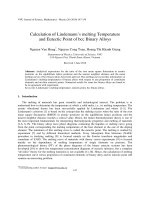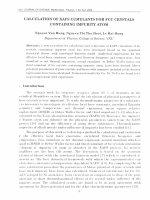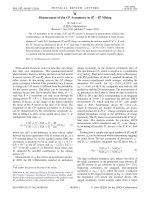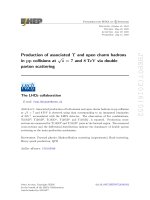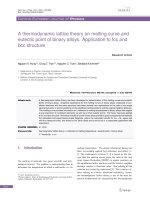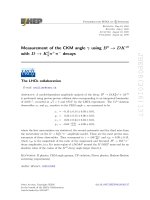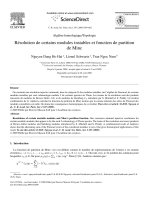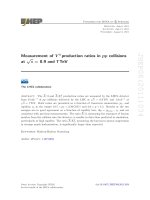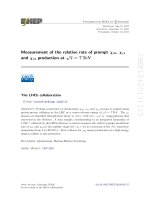DSpace at VNU: Calculation of Lindemann's melting Temperature and' Eutectic Point of bcc Binary Alloys
Bạn đang xem bản rút gọn của tài liệu. Xem và tải ngay bản đầy đủ của tài liệu tại đây (691.98 KB, 8 trang )
VNU Joumal of Science, Mathematics - Physics 26 (2010) 147-154
Calculation of Lindemann's melting Temperature
and' Eutectic Point of bcc Binary Alloys
Nguyen Van Hung., Nguyen Cong Toan, Hoang Thi Khanh Giang
Departunent of Physics, Hanoi University of Science,
334 Nguyen Trai, Thanh Xuan, Hanoi, Vietnam
Received
I
WU
June 2010
Abstract. Analytical expressions for the ratio of the root mean square fluctuation in atomic
positions on the equilibrium lattice positions and the nearest neighbor distance and the mean
melting cgryes of bcc binary alloys haye been derived. This melting curve provides information on
Lindemann's melting temperatures of binary alloys with respect to any proportion of constituent
elements and on their euctectic points. Numerical results for some bcc binary alloys are found to
be in agreement with experiment.
Keywords: Lindemann's melting temperature, eutectic point, bcc binary alloys.
i
1. Introduction
The melting of materials has great scientific and technological interest. The problem is to
understand how to determine the temperature at which a solid melts, i.e., its melting temperature. The
atomic vibrational theory has been successfully applied by Lindemann and others [1-5]. The
Lindemann's criterion [1] is based on the concept that the melting occurs when the ratio of the root
mean square fluctuation (RMSF) in atomic positions on the equilibrium lattice positions and the
nearest neighbor distance reaches a critical value. Hence, the lattice thermodynamic theory is one of
the most important fundamentals for interpreting thermodynamic properties and melting of materials
going
U-6, 8-151. The binary alloys have phase diagrams containing the liquidus or melting curve
doping
of
the
the
one
to
host
element
the
of
melting
temperature
the
from the point corresponding
element. The minimum of this melting curve is called the eutectic point. The melting is studied by
experiment [7] and by different theoretical methods. X-ray Absorption Fine Structure (XAFS)
procedure in studying melting [8] is focused mainly on the Fourier transform magnitudes and
cumulants of XAFS. The melting curve of materials with theory versus experiments [9] is focused
mainly on the dependence of melting temperaflre of single elements on pressure. The
phenomenological theory @T) of the phase diagranrs of the binary eutectic systems has been
developed [10] to show the temperature-concentration diagrams of eutectic mixtures, but a complete
"ab initio" theory for the melting transition is not available [11,16]. Hence, the calculation of melting
temperature curve versus proportion of constituent elements of binary alloy and its eutectic point still
remains an interesting problem.
author.
E-mail:
A7
-corr.rponding
r48
N,v' Hung et al.
/ w[J
Journal of science, Mathematics - physics 26 (20]0) I4T-l54
The purpose of this work is to develop a thermodynamic lattice theory for
analytical calculation of
the mean melting curves and eutectic points of bcc binary alloys. This melting
curve provides
information on Lindemann's melting temperafures of binary alloys with respect
to
proportion
of
any
constifuent elements and on the eutectic points. Numerical results for some
bcc binary alloys are found
to be in agreement with experiment [7].
2.
Formalism
The binary alloy lattice is always in an atomic thermal vibration so that in the
lattice cell n the
atomic fluctuation function, denoted by number I for the I't element and by number
2 for the
element composing the binary alloy, is given by
rJ
,,
:
I4t",,"r'*, + uio"-,'.*, ), U,, = ;1(uro",r.^n
='r"t'o',
lt2o
+
u)oe-itx,),
2"d
(l)
:llreiact,
(2)
where atristhe lattice vibration frequency and q is the wave number.
The atomic oscillating amplitude is characteri zed, by the mean square displacement
(MSD) or
Debye-Waller factor (DWF) 13,l2-l5l which has the form
'r,
w
where
K is the scattering
=!lk.u-l'
., Hl
-q
ltl
(3i
.
vector equaling a reciprocal lattice vector, and
u,
is the mean atomic
vibration amplitude.
It is apparent that 1/8 atom on the vertex and one atom in the center of the bcc are localized
in an
elementary cell' Hence, the total number of atoms in an elementary cell
is 2. Then if on average s is
atomicnumberof[pe land(2-s)isatomicnumberoftype2,thequantiwio isgivenby
rurq + Q-thro
uo=
2
(4)
The potential energy of an oscillator is equal to its kinetic energ"y so that
the mean energy of atom
kvlbratingwith wave vector q has the form
Eo = M
Hence, using Eqs.
(2,5)
s
=
the mean energy
ol"rf
(5)
of the crystal consisting of N lattice cells is given by
* 1z - s)M ,ollrr,l'),
Iq' Eo =Zulu,ot]l",ol'
\
;
(6)
Mz are the masses of atoms of types I and,2,respectively.
Using the relation between uroand uro fl3f,i.e.,
where, Mr,
Itro=mttrq,
m=Mr/Mz,
and Eqs. (5, 6) we obtain the mean energy for the atomic vibration
with wave vector
e)
4r
N.V. Hung et al.
/ VNUJournal
E
o
of Science, Mathematics - Physics 26 (2010)
= Not]lr,rl'br,
+M
r() -
147-154
t)*'1.
149
(8)
The mean energy for this qthlattice mode calculated using the phonon energy
with noas the mean
number of oscillators is given by
eo =
z(n,
*L)nr,
(e)
.
2,/
\
Hence, comparing Eq. (8) to Eq. (9) we obtain
. l)
o+;l
+ (2
(10)
- lml'
Using Eq. (a) and Eq. (7) the mean atomic vibration amplitude has the form
t-P
lrnl
1r la \ r2t
:4[t*\z-s)m]
vtql
12
(1 1)
.
To study the MSD Eq. (3) we use the Debye model, where all three vibrations have the same
velocity [3]. Hence, for each polarization With taking Eq. (11) into account we get the mean value
l*",11
: L K'lu,l' =
|r'[' *
(z
- r)*\'lu,ol'
(r2)
.
When taking all three polarizations the factor 1/3 is omitted, so that using Eq. (10) the MSD or
DWF Eq. (3) with all three polarizations is given by
I
11
, =;\*'1"[
=i\
(1
3)
-(tq
Transforming the sum over q into the corresponding integral [3], Eq. (13) is changed into the
following form
, : 1 *'[, * (z - e*]h'
Denoting z =ho I kBT , k r0o
[
{;"-. :}#,
(14)
=hato with oo , 0o as Debye frequency and
temperature,
respectively, we obtain
, =1*,[, + (z - n^]#p;']
Since we consider the melting,
-==
e"-l
1, and
12
{*.
it is sufficient to take the hight
(15)
I}^"
temperatures
(T >> d, ) so that
O, then the DWF Eq. (15) with using Eq. (7) is given by
w
"
n"!r,+(2-slMrlt2K2T
2.Ltnt
-4
MlM 2kuezD '
which is linearly proportional to the temperature T as it was shown already [3, 14].
From Eq. (12) with using Eq. (3) for W we obtain
;
flf)
r50
N.v. Hung et al.
/ wu
Journal of science, Mathematics - physics 26 (20r0) 147-154
Ll",ol'
=
q
24tI/
(r7)
K'[r* Q-gmf''
The mean crystal lattice energy has been calculated
a
:ZM
=ZZu rrllu,,l'
ol,
(18)
.
^l' k,, q
k,n
Using this expression and Eqs. (6, 7) we obtain the atomic MSF in the form
*'Zlu,,l'
!>'l',,1'=
Na
o
(1e)
'
whiih by using Eq. (17) is given by
24mzW
=
|>lu,.f
(20)
'
K'b * Q- gmf'z
Using W from Eq. (16) this relation is resulted as
I sr,, 12
l8m2lt2T
(2r)
lyLluz,l=M
Hence, at T>>0o the MSF in atomic positions about the equilibrium lattice positions is
determined by Eq. (21) which is linearly proportional to the temperature T.
Therefore, at a given temperature T the quantity R defined by the ratio of the RMSF in
atomic positions about the equilibrium lattice positions and the nearest neighbor distance d is
.
given by
lSm2hzT
R_
(22)
M,b * e - gmlk,o'r6z '
on the Lindemann's criterion the binary alloy will be melted when this value R
Based
reaches a threshold value Rr, then the Lindemann's melting temperature
alloy is defined as
lsM, + (2 - iM,]
. _ R'^kre'od'
T^=E
,t,,)(=-ff,
lgm
^.
If we
denote x as proportion of the mass of the element
I in
From this equation we obtain the mean number of atoms in the element
lattice cell
m(l- x)+ x
(23)
the binary alloy, then we have
(24)
sM,+(z-t)u,'
2x
for a bcc binary
-l
R'^=#Zlu,,f'
sM,
s'=
T,
1
for each binary alloy
(2s)
We consider one element to be the host and another dopant. If the tendency to be,the host is equal
for both constifuent elements, we can take averaging the parameter m withrespect to the atomic mass
proportion of the constituent elements in alloy as follows
N.V. Hung et al.
/ wLI Journal of science,
n
"'
Mathematics - Physics 26 (2010) 147-154
=!l,L+(z-,)l1,-'l
2l'u' "'tut')
151
(26)
This equation can be solved using the successive approximation. Substituting the zero-order with s
from Eq. (25) in this equation we obtain the one of the 1" order
(t
-
*W'.
["
-G
fh]* - *az : o,
(27)
which provides the following solution
m=
ft-,\Y'f*Jr
-["'Mr)
L
z(t- x)
, A:
["-O
-
fh]+ +x(t-.)h,
(28)
replacing m inEq. (23) for the calculation of Lindemann's melting temperatures.
The threshold value R, of the ratio of RMSF in atomic positions on the equilibrium lattice
positions and the nearest neighbor distance at the melting is contained in 7 which will be obtained by
an averaging procedure. The average
form of Eq. (23) containing
R),
realized based on the first order
average for
7t''
ofy
can not be directly based
i.e., the second order
ony, and Trbecause it has the
of R,, while the other
averages have been
of the displacement as Eq. (22). That is why we have to perform
andthenobtain
[
-,,
z :F^lr,
,-h
+ (2 - s)l
r,) /4,
QN
containing7 for the l't element andTrfor the 2nd element, for which we use the following limiting
values
tz=97^(z)/M2,s=0; It:97,(r'tlMvs=2
(30)
with [,11y and T,p1as melting temperatures of the first or doping and the second or host element,
respectively, composing the binary alloy.
Therefore, the melting temperature of bcc binary alloys has been obtained actually from our
calculated ratio of RMSF in atomic positions on the equilibrium lattice positions and nearest
neighbour distance Eq. (22), which contains contribution of different binary alloys consisted of
different pairs of elementS with the masses M1 and Mz of the same bcc structure.
The eutectic point is calculated using the condition for minimum of the melting curve, i.e.,
dT^
:0.
(3 1)
dx
3.
Numerical results and comparison to experiment
Now we apply the derived theory to numerical calculations for bcc binary alloys.'According to the
phenomenological theory GT) [10] Figure I shows the typical possible phase diagrams of a binary
alloy formed by the components A and B, i.e., the dependence of temperature T on the proportion x of
ts2
N.V. Hung et sl.
/
VNU Journal of Science, Mathematics - Physics 26 (2010) 147-154
element B doped in the host element A. Below isotropic liquid mixture L, the liquidus or melting
curve beginning from the melting temperature Ta of the host element A passes through a temperature
minimum TB known as the eutectic point E and ends at the melting temperature Ts of the doping
element B. The phase diagrams contain two solid crystalline phases o and p. The eutectic point is
varied along the eutectic isotherm T : Ts. The eutectic temperafure Ts can be a value lower Ta and Tn
(Figure la) or i.r the limiting cases equaling Tn (Figure 1b) or Ts (Figure 1c). The mass proportion.x
characteizes actually the proportion of doping element mixed in the host element to form binary alloy.
T
Trn
(a)
Fig.
(b)
1. Possible
typical phase diagrams of
a
(c)
binary alloy formed by components A and B.
lvblting curve, preseri
315
5 310
F
o Eutectic poiril, present
- ' - lrellingcurve, Expt., Ref.7
! Eutectic point, Expt., Rei 7
temperature, Cs, Ref. 6
^o I'ilelting
lrlelting temperafure, Rb, Re[ 6
cs,-rRb,
Y
F
E 305
f
e
o
3oo
//t/
E 295
o
F
ztoo
E
E
2600
E
(D
24oo
c)
o
-+
o
'
c
lvHting cune, present
l/bftirE temperature of Cr, Rei 6
ftibltirE temperature of [/b, Rel 6
Eutectic point, present
MettirE temperature, Expt., Ref. 7
Eutectic point, Expt., Rei 7
2soo
F
290
285
0.4
0.6
Proportion x of Rb
0.4
0.6
Proportion x of Mo
Fig. 2. Calculated melting curyes and eutectic points of binary alloys Cs1-*Rb", Cry-,Mo"compared to
experimental phase diagrams [7].
Our numerical calculations using the derived theory are focused mainly on the mean melting
curyes providing information on the Lindemann's melting temperatures and eutectic points of bcc
binary alloys. All input data have been taken from Ref. 6. Figure 2 illustrates the calculated melting
curves of bcc binary alloys Csr-*Rb, and Cr1-lVlo, compared to experiment [7]. They correspond to the
case of Figure la of the PT. For Cs1-*Rb, the calculated eutectic temperature Ts : 288 K and the
eutectic proportion xs:0.3212 are in a reasonable agreement with the experimental values Tp : 285.8
K and.xe = 0.35 [7], respectively. For Cr1-*l\4o, the calculated eutectic temperature TE:2125 K agrees
N.V. Hung et al.
/ wu
Journal of science, Mathematics - Physics 26 (2010) 147-154
153
:
well with the experimental value TB:2127 K [7] and the caiculated eutectic proportion lB 0'15 is in
a reasonable agreement with the experimental value xB:0.20 [7]. Figure 3 shows that our calculated
melting curve for Fer-*V* corresponds to the phase diagram of Figure lb and for Cr1-*Cs* to those of
Figure 1c of the PT. Table I shows the good agreement of the Lindemann's melting temperatures
taken from the calculated melting curve with respect to different proportions of constituent elements of
binary alloy Css-*Rb, with experimental values [7].
cr',-rcs"
o
- El
o
ltilelting curve, present
lvldtirE temperature of Cr, Ref. 6
lvldtirE temperature of Cs, Re[ 6
Eutectic point, present
Y
-E 1500
YI
- 21001
(E
o
E
o
1000
F
0
0.6
0.4
02
08
1
o
Mass proportion x of V
o.2
0.4
0.6
0.8
1
Prooortion x of Cs
Fig. 3. Calculated melting curve and eutectic point of binary alloys Fe1-*V* and Cr1-*Cs*.
Table
l.
Comparison of calculated Lindemann's *inrn, temperatures T,(K) of Csr-*Rb' to experiment t7] witfi
respect to different proportions x ofRb doped in Cs to formbinary alloy
Proportion x of Rb
0.10
T,(K),
Present
292.6
0.30
287.5
T-K).
Exp. [7]
291.4
286.0
4.
0,50
290.0
287.4
0.70
295.0
293.5
0.90
305.0
304.0
Conclusions
In this work a lattice thermodynamic theory on the melting curves, eutectic points and eutectic
isotherms of bcc binary alloys has been derived. Our development is derivation of analytical
expressions for the melting curves providing information on Lindemann'smelting temperatures with
respect to different proportions of constituent elements and eutectic points of the binary alloys.
The significance of the derived theory is that the calculated melting curves of binary alloys
correspond to the experimental phase diagrams and to those qualitatively shown by the
phenomenological theory. The Lindemann's melting temperatures of a considered binary alloy change
from the melting temperature of the host element when the whole elementary cell is occupied by the
atoms of the host element to those of binary alloy with respect to different increasing proportions of
the doping element and end at the one of the pure doping element when the whole elementary cell is
occupied by the atoms of the doping element.
154
N.V. Hung et al.
/ WUJournal
of Science, Mathematics - Physics 26 (2010) 147-154
Acknowledgments. This work is supported by the research project
QG.08.02 and by the research
project No. 103.01.09.09 of NAFOSTED.
References
tll
I2l
t3]
[4] .
t5l
t6]
I7l
t8]
t9]
tl0]
tl l]
Il2l
t13]
U4]
[15]
tl6]
F.A. Lindemann, Z. Phys. I I (1910) 609.
N. Snapipiro, Phys. Rev. B | (1970)3982.
J.M. Ziman, Principles of the Theory of Solids,Cambrige University Press, London, 1972.
H.H. Wolf, R. Jeanloz, J. Geophys. Res. 89 (1984)782t,
R.K. Gupta, Indian I phys. A 59 (1985) 315.
Charles Kittel, Introduction to Solid State Physlcg 3rd Edition (Wiley, New
york,
1986).
T'B' Massalski, Binary Alloy Phase Diagrams,2nd ed. (ASM Intem. Materials Parks, OH, 1990).
E.A. Stern, P. Livins, Zhe Zhang, phys. Rev B, Vol. 43, No.l I (1991) gg50.
D. Alfb, L. vodadlo, G.D. Price, M.J. Gillan, J. phys.: condens. Matter 16 (2004) sg37.
Denis Machon, Pierre Toledano, Gerhard Krexner, phys. Rev, B 7l (2005) O24llO.
H. Lowen, T. Palberg, R. Simon, Phys. Rev. Leu.70 (1993) 15.
N.V. Hung, J.J. Rehr, Phys. Rev. B 56 (1997) 43.
M. Daniel, D.M. Pease, N.V. Hung, J.I. Budnick, phys. Rev. B 69 eOO4) 134414.
N.V. Hung, Paolo Fomasin i, J. Phys. Soc. Jpn. 76 (2007) 084601.
N.V. Hung, T.S. Tien, L.H. Hung, R.R. Frahm, Int. J. Mod. phys. B 22 (2OOB) 5t55.
Charusita Chakravaty, Pablo G. Debenedetti, Frank H. Stillinger,
I
Chem.
phys.
126 (2007)20450g.
